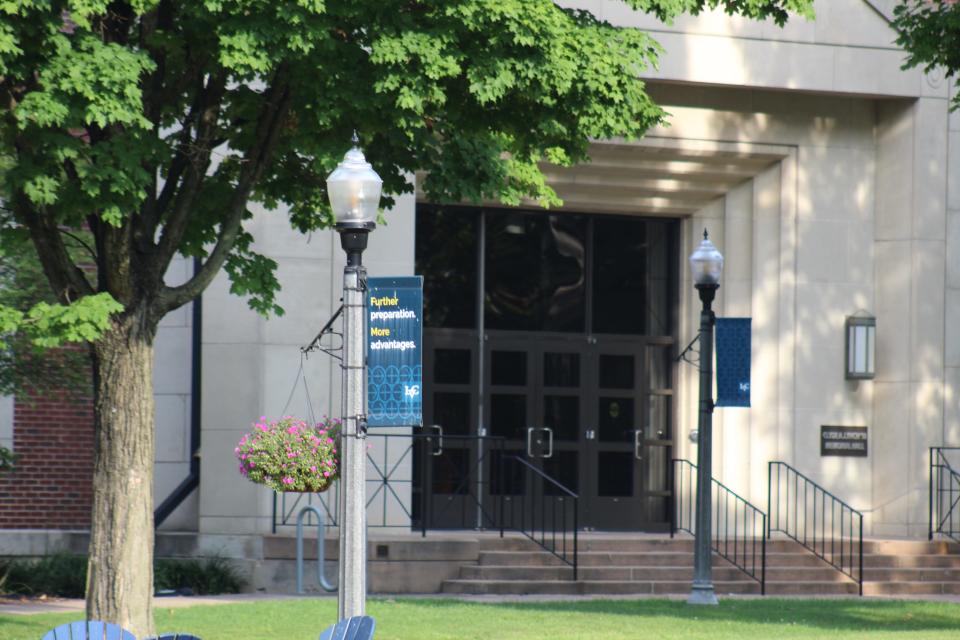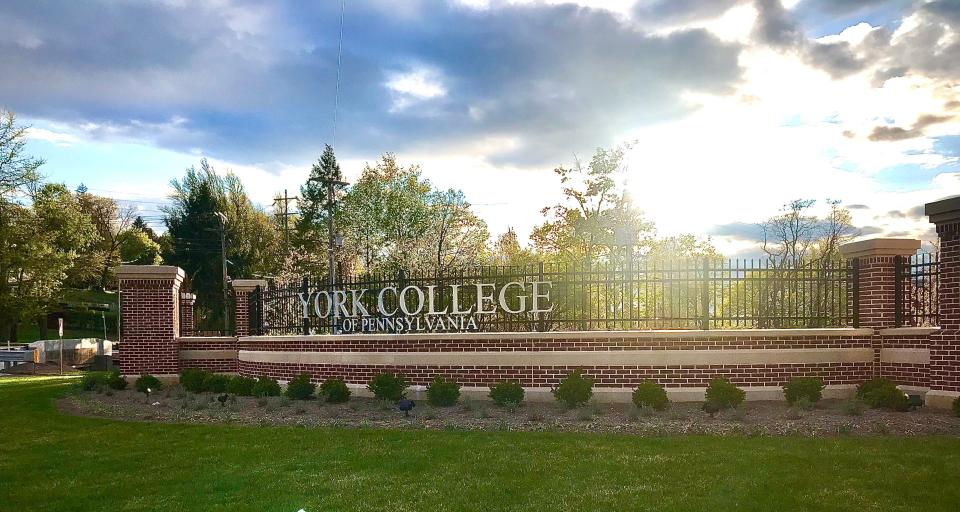Small, private Central PA colleges see an upswing in enrollment, but a drop-off is looming
Despite college enrollment being down in recent years across the board, as more and more potential freshman choose to join the workforce over enrolling in classes − an issue accelerated by the first year of the pandemic − some small private colleges in central Pennsylvania are seeing an upswing of students for this year's incoming class.
Earlier this summer, Lebanon Valley College announced that its total undergraduate enrollment would be at an all-time high of 1,648 students.
"If classes began today, on Aug. 10, this would be the largest incoming class. When we define class we're talking first year students and transfers," said Edwin Wright, vice president of enrollment management at LVC. "So our number right now, we're just around 480, I think it's 481, and right now we have 55 transfers. So those two combined would be 536, and I think the largest class we've ever had is like 523."

Wright explained that, since students hadn't moved into the school yet, that number could be slightly lower a couple months into the semester.
Compared to 2020, with 465 first year students and transfers, that's quite the upswing for the small private school.
The school later found that during that first pandemic year, 20% of students that LVC initially enrolled didn't go to any college at all.
"Part of how we were successful this year compared to other years was that we did have a higher conversion of enrolling students that we admitted, it's a term in the industry that we call yield," Wright said.
He explained that the school generally accepts around 2,400 applications, much more than what it would be able to actually admit into the school, in order to get the desired enrollment numbers. This year, applications were relatively lower than previous years and offers of admission were flat, but they got more to accept those offers than they had before.
Despite the initial pandemic year, Wright said that LVC's enrollment figures have been relatively flat. Relative to other schools, some he said that are seeing sharp spikes upward and then sharp spikes downard in enrollment, flat is a good thing.
How they did it
Cultivating increases, or at the very least a stabilization of enrollment in the school, has been a years-long project for Lebanon Valley College.
One thing that has added interest in the school, and over 30 students to the incoming class, is the nursing program, now in its second year. Later this fall, the school will open its new nursing building, which will allow more students to enroll in the major.
Outside-of-class activities, offerings of community and personal enrichment such as marching band and athletics, are also large drivers when it comes time for students to make a decision.
LVC has invested greatly in athletics, Wright said, adding additional capacity on some sports teams by introducing JV programs or increasing roster sizes.
"The outside-the-classroom experience, to me, is just as valuable as the inside-the-classroom experience. Because every college has an English major, every college has a business program or something like that. But when you add the business and the marching band, or the soccer team, or the theater program."
Wright believes that if the school didn't make these kinds of investments, LVC's enrollment would likely be in steep decline.
"I think everyone is doing things that they think is going to attract a 17- or 18-year-old to their campus. Some it might be renovating the residence halls, or it might be building a rock wall in the gym. Schools do investments but some are paying off more than others."
Things like campus tours, the size of the school and the overall safety of the Annville area are all factors that help with students choosing to attend the school.

York College on the upswing as well
Other schools in Central Pennsylvania have seen projected growth as well. York College, for example, has seen a nearly 5% increase in enrollment over last year, about 775 first-year students and 150 new transfer students, making it the largest incoming class since 2018.
Part of what has increased enrollment is recent work to keep communication open and consistent with students and parents on what they need to be doing in the summer to ensure they're ready to start in the fall.
Brian Hazlett, vice president for enrollment management at York College, said that a lot of the success has come from direct outreach to high school students in the five surrounding counties, forming pipelines directly to the school.
The school has rapidly expanded its dual enrollment program, allowing high school students to take college courses for credit while also fulfilling high school requirements, from about 25 students to well over 100. Because dual enrollment students tend to be high school juniors, the school won't be able to truly tell whether the investment has paid off until next year.
In an attempt to help with continued teacher shortages, the York College has partnered with Dallastown Area High School, allowing professors to come to the school's future teachers club to try and get students interested in teaching, and in particular, let them know that York College is a good fit for those who want to pursue an education degree.
Education: Looking to retain educators, these school districts invest in employee health
Another initiative at York College is getting potential new students in to physically visit the campus. It began offering a $1,000 incentive to first semester bills if students came during the summer to visit the campus last year, and continued the initiative for this summer.
York College has also been invested in first year students, which make up roughly 18% of the school's overall population, attempting to tailor its summer communications for that population of students.
"Not only looking at what are we doing to entice students that are coming from 90 miles plus to come enroll at our institutions, but what are we doing as that local institution that can help build partnerships and relationships with local high schools," said Hazlett. "That's been critically important for us."
The looming threat of the enrollment cliff
Schools are anticipating another drop in enrollment in the coming years: the enrollment cliff.
"In the simplest terms, it's really the traditional college age student population in the Northeast is really slated to decline over the next four to five years," said Hazlett. "And it's really just, you know, directly related to birth rates that were down in the Northeast, and now there's not that insurgence of population growth in this area that we may have typically seen 10 years, 15 years ago."
In a study published by Western Interstate Commission for Higher Education in 2020, Pennsylvania, one of 10 states that have historically helped to produce 56% of the U.S. total of high school graduates, was projected to see a 3% increase between 2019 and 2025, followed by a 9% decrease from 2025 through 2037.
Other states in the Northeast, such as Vermont, New York, New Hampshire and Rhode Island, are poised to see double-digit declines between 14% to 18% from 2019 through 2037.
There are 300 plus colleges in Pennsylvania, making it a highly competitive marketplace when trying to meet enrollment goals.
York College hopes its investments in regional recruitment at the high school level, as well as investments into career-focused and hands-on programs such as nursing and engineering, will help the school stand out.
To help guide the school enrollment goals, they've developed a five-year strategic enrollment management plan that focuses directly on the kinds of enrollment they want to see in enrollment in the future, as well as how they can better target those demographics.
Wright said the enrollment cliff could affect some schools more than others because schools like LVC, which draws most of its students from within 75-100 miles from campus, will have a smaller number of potential students than a school that recruits on a national level.
"I think colleges are prepping to weather the storm by just right sizing their budget," Wright said. "Mostly through expenses, like just maybe not hire as much faculty, particularly maybe in majors that are not as popular."
One of the things that LVC is doing to help weather that storm is making the school more transfer friendly by accepting credits from more schools and working to allow students to still be able to graduate in four years, seeing the transfer population as a way for the school's enrollment to stay flat or even expand during project demographic decline.
Franklin & Marshall's strategy
Lancaster-based Franklin & Marshall, which is also seeing its largest class since the pandemic, with a freshman class between 550 and 560 students, is also concerned with the the enrollment cliff. This concern comes even when the school has made the strategic decision to flatten the total student body at the school from the about 2,400 students they were seeing before the pandemic to the around 2,000 students they're seeing now, in an effort to bring some sustainability and efficiency to the campus, both financially as well as for the student body.
Still, the school has employed three full-time recruiters, one in northern Virginia, one in California and one in Texas.
They've also hired a second full-time international recruiter to better diversify the school's international population, which makes up roughly 20% of the school's student body.
Ev's in Central Pa.? What is the real cost of charging an electric vehicle at home in Central Pennsylvania?
While these new recruitment efforts not only allow the school to demographically diversify its population, their locations were planned with the cliff in mind.
"Two of the three markets that we have recruiters based in today that we didn't have them based in five years ago or ever, honestly," said Hillen Grason, dean of admissions at Franklin & Marshall, "was looking at how the demographics were projected to shift over the next 10 to 12 years, and knowing there's going to be growth in the southern united states in terms of high school graduates, there's going to be growth in high school graduates in a number of western states.
"Putting members of our team in those markets where they can cultivate and build relationships on the ground, while institutionally we can really build our brand in those markets so when the proverbial cliff comes and goes, we're in a position to weather that cliff and shift in demographics better than maybe some other institutions."
Daniel Larlham Jr. is a reporter for the Lebanon Daily News. Reach him at DLarlham@LDNews.com or on X, formerly twitter @djlarlham
This article originally appeared on Lebanon Daily News: Small, private Central PA colleges seeing an upswing in enrollment

